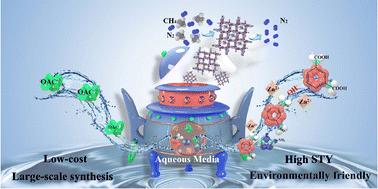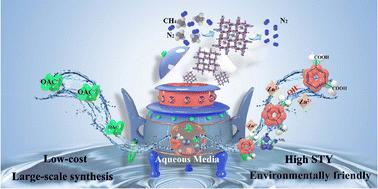在水介质中绿色、可扩展地合成具有前所未有时空产率的双配体 Zn-MOF,实现高效的 CH4/N2 分离
IF 9.2
1区 化学
Q1 CHEMISTRY, MULTIDISCIPLINARY
引用次数: 0
摘要
数十年的研究揭示了金属有机框架(MOFs)的无限潜力。然而,由于其生产过程涉及大量有机溶剂,既危险又昂贵,严重限制了其在工业领域的广泛应用。在此,我们将碱辅助合成和调制水热化学这两种环保策略的优势进行了互补整合,并引入醋酸阴离子作为温和有效的调制剂,以调节配位和定制结晶途径。因此,在水介质中实现了双配体 Zn-MOF 的绿色、快速和可扩展合成,其产量达到前所未有的时空产量,每天每立方米 24 吨,批量超过一公斤(即 1.2 公斤)。由于 Zn-MOF 对 CH4 有很强的亲和力,它在环境条件下具有相当大的 CH4/N2 分离能力。这项研究不仅促进了 MOFs 的绿色和规模化生产,还为 CH4 回收提供了一种经济高效的吸附剂。本文章由计算机程序翻译,如有差异,请以英文原文为准。


Green and scalable synthesis of a dual-ligand Zn-MOF with unprecedented space–time yield in aqueous media and efficient CH4/N2 separation†
Decades of research unveiled the unlimited potential of metal–organic frameworks (MOFs). Nevertheless, the hazardous and expensive production involving massive amounts of organic solvents has severely limited their widespread industrial adoption. Herein, the advantages of two eco-friendly strategies, base-assisted synthesis and modulated hydrothermal chemistry, were complementarily integrated, with the acetate anion introduced as a mild and efficacious modulator to regulate the coordination and tailor the crystallization pathway(s). The green, rapid, and scalable synthesis of a dual-ligand Zn-MOF was thereby achieved in water media, featuring an unprecedented space–time yield of 24 ton per m3 per day and a batch size exceeding a kilogram (i.e., 1.2 kg). Owing to its strong affinity toward CH4, the acquired Zn-MOF demonstrated a considerable CH4/N2 separation capacity under ambient conditions. This study not only facilitates the green and scalable production of MOFs but also offers a cost-effective adsorbent for CH4 recovery.
求助全文
通过发布文献求助,成功后即可免费获取论文全文。
去求助
来源期刊

Green Chemistry
化学-化学综合
CiteScore
16.10
自引率
7.10%
发文量
677
审稿时长
1.4 months
期刊介绍:
Green Chemistry is a journal that provides a unique forum for the publication of innovative research on the development of alternative green and sustainable technologies. The scope of Green Chemistry is based on the definition proposed by Anastas and Warner (Green Chemistry: Theory and Practice, P T Anastas and J C Warner, Oxford University Press, Oxford, 1998), which defines green chemistry as the utilisation of a set of principles that reduces or eliminates the use or generation of hazardous substances in the design, manufacture and application of chemical products. Green Chemistry aims to reduce the environmental impact of the chemical enterprise by developing a technology base that is inherently non-toxic to living things and the environment. The journal welcomes submissions on all aspects of research relating to this endeavor and publishes original and significant cutting-edge research that is likely to be of wide general appeal. For a work to be published, it must present a significant advance in green chemistry, including a comparison with existing methods and a demonstration of advantages over those methods.
 求助内容:
求助内容: 应助结果提醒方式:
应助结果提醒方式:


